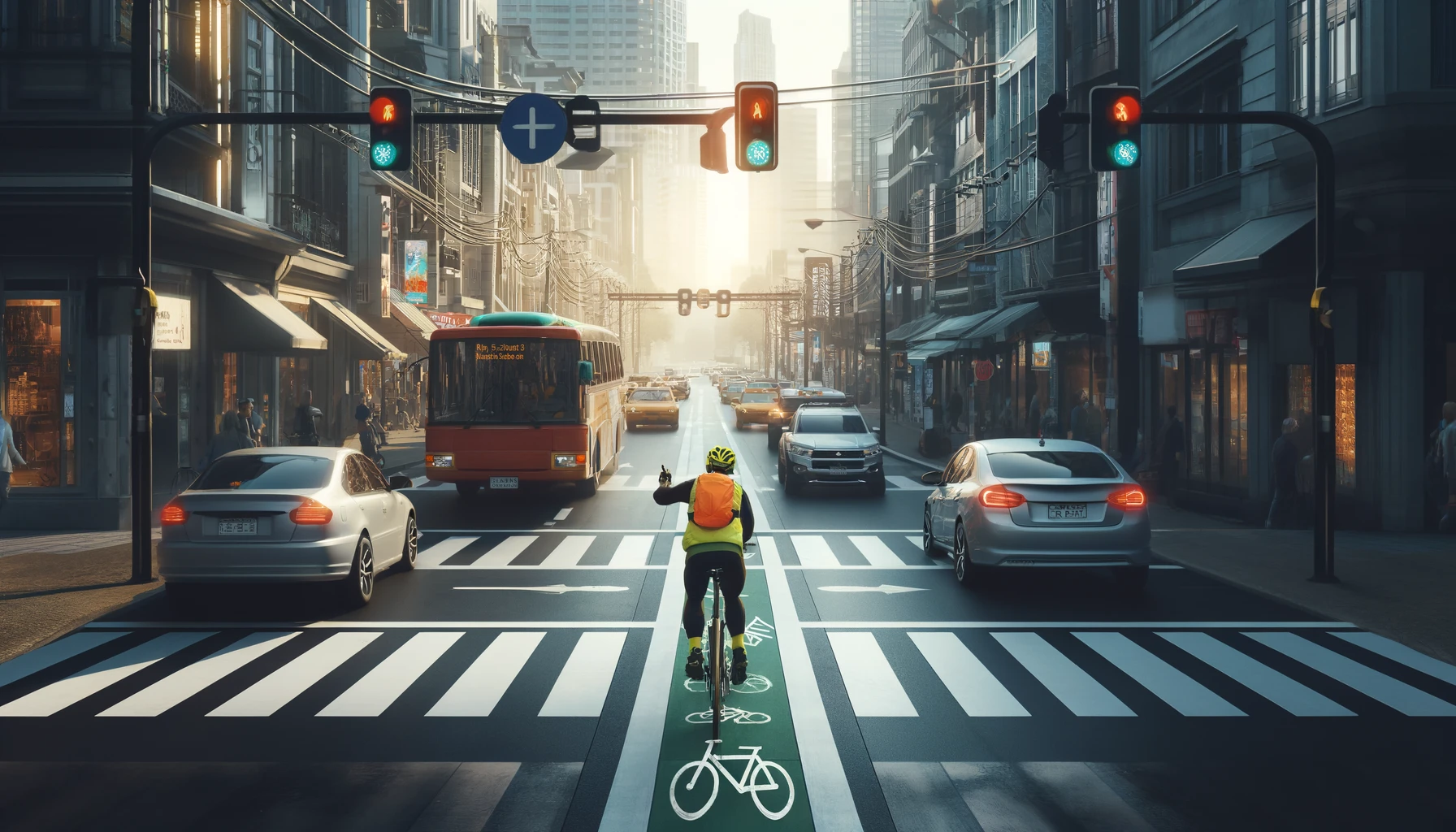
10 Most Likely Ways to be Hit By a Car While on a Bicycle
With soaring gas prices, its no wonder that more urbanites are opting for pedal power than ever before.
Combine this with the following: that there are more vehicles on the road than ever before and the fact that most of our urban areas were never designed for the current volume of traffic, particularly with the urbanization/condo development everywhere, and you have a recipe for problems. Thus bicycle safety is more important than ever.
Traffic accidents involving cyclists and pedestrians are at an all time high. At least some cities are proactively addressing this issue with smarter legislation, increased public transit funding and more bike paths/lanes.
While statistics suggest that drivers making left-hand turns are the most fatal for pedestrians, there are more situations where cyclists can be hit by a car. The following is a comprehensive detail of those potential accidents.
The Most Likely Ways to be Hit By Cars When Cycling
Collision Type #1: The Right Cross
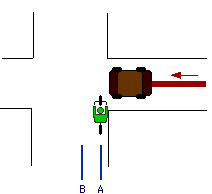
How to avoid this collision:
1. Get a headlight. If you're riding at night, you absolutely should be using a front headlight. It's required by law, anyway. Even for daytime riding, a bright white light that has a flashing mode can make you more visible to motorists who might otherwise Right Cross you. Look for the new LED headlights which last ten times as long on a set of batteries as old-style lights. And headlamps (mounted on your head or helmet) are the best, because then you can look directly at the driver to make sure they see your light.
2. Wave. If you can't make eye contact with the driver, wave your arm. It's easier for them to see your arm going left and right than it is for them to see a bicycle coming straight towards them. You could also use a loud horn (like the Air Zound) to get drivers' attention. If it looks like the driver is about to pull out without seeing you, yell "Hey!" You may feel awkward waving or yelling, but it's better to be embarrassed than to get hit. Incidentally, many countries require bells on bicycles, but the U.S. doesn't.
3. Slow down. If you can't make eye contact with the driver (especially at night), slow down so much that you're able to completely stop if you have to. Sure, it's inconvenient, but it beats getting hit. Doing this has saved my life on too many occasions to count.
4. Ride further left. You're probably used to riding in the "A" line in the picture, very close to the curb, because you're worried about being hit from behind. But take a look at the car. When that driver is looking down the road for traffic, he's not looking in the bike lane or the area closest to the curb; he's looking in the middle of the lane, for other cars. The farther left you are (such as in "B"), the more likely the driver will see you.
There's an added bonus here: if the motorist doesn't see you and starts pulling out, you may be able to go even farther left, or may be able to speed up and get out of the way before impact, or easily roll onto their hood as they slam on their brakes. In short, it gives you some options. Because if you stay all the way to the right and they pull out, your only "option" may be to run right into the driver's side door.
Using this method has saved me on three occasions in which a motorist ran into me slowly as they hit their brakes and I wasn't hurt, and in which I definitely would have slammed into the driver's side door had I not moved left.
You might worry that moving left makes you more vulnerable to cars coming from behind. But the stats say you're far more likely to get hit by a car at an intersection ahead of you that can't see you, than from a car behind you which can see you clearly.
So while both positions have risk, you generally reduce your risk by riding a little farther left. Your actual lane position depends on road conditions. On fast roadways with few cross streets (and thus less chances to get hit at intersections), you'll ride farther to the right. On slow roads with many cross streets, you'll ride farther left.
Collision Type #2: The Door Prize
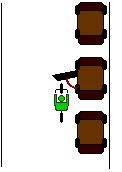
How to avoid this collision:
Ride to the left. Ride far enough to the left that you won't run into any door that's opened unexpectedly. You may be wary about riding so far into the lane that cars can't pass you easily, but you're more likely to get doored by a parked car if you ride too close to it than you are to get hit from behind by a car which can see you clearly.
Collision Type #3: The Crosswalk Slam

How to avoid this collision:
1. Get a headlight. If you're riding at night, a headlight is absolutely essential. It's required by law, anyway.
2. Slow down. Slow down enough that you're able to stop completely if necessary.
3. Don't ride on the sidewalk in the first place. Crossing between sidewalks is a fairly dangerous maneuver. If you do it on the left-hand side of the street, you risk getting slammed as per the diagram. If you do it on the right-hand side of the street, you risk getting slammed by a car behind you that's turning right.
Sidewalk riding also makes you vulnerable to cars pulling out of parking lots or driveways. And you're threatening to pedestrians on the sidewalk, who could get hurt if you hit them. These kinds of accidents are hard to avoid, which is a compelling reason to not ride on the sidewalk in the first place. In addition, riding on the sidewalk is illegal in some places.
Some special sidewalks are safe to ride on. If the sidewalk is really long (no need to frequently cross streets), and free of driveways and peds, then there's little risk to you and others.
Just make sure when you do cross a street or driveway that you slow down considerably and that you check the traffic in all directions, especially behind you if you're riding with the flow of traffic.
Collision Type #4: The Wrong-Way Wreck
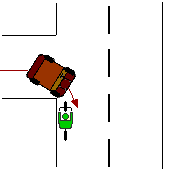
Even worse, you could be hit by a car on the same road coming at you from straight ahead of you. They had less time to see you and take evasive action because they're approaching you faster than normal (because you're going towards them rather than away from them).
How to avoid this collision:
Don't ride against traffic. Ride with traffic, in the same direction.
Riding against traffic may seem like a good idea because you can see the cars that are passing you, but it's not. Here's why:
- Cars which pull out of driveways, parking lots, and cross streets (ahead of you and to the left), which are making a right onto your street, aren't expecting traffic to be coming at them from the wrong way. They won't see you, and they'll plow right into you.
- How the heck are you going to make a right turn?
- Cars will approach you at a much higher relative speed. If you're going 15mph, then a car passing you from behind doing 35 approaches you at a speed of only 20 (35-15). But if you're on the wrong side of the road, then the car approaches you at 50 (35+15), which is more than twice as fast! Since they're approaching you faster, both you and the driver have lots less time to react. And if a collision does occur, it's going to be at a faster relative speed.
- Riding the wrong way is against the law and you can get ticketed for it.
One study showed that riding the wrong way was three times as dangerous as riding the right way, and for kids, the risk is seven times greater.
Nearly one-fourth of crashes involve cyclists riding the wrong way. Some readers have challenged this, saying if 25% of crashes are from going the wrong way, then riding the right way is more dangerous because it accounts for 75% of crashes.
That idea is just wrong. First off, only 8% of cyclists ride the wrong way, yet nearly 25% of them get hit -- meaning wrong-way cyclists really are three times more likely to get hit than those who ride the proper way. Second, the problem with wrong-way biking is that it promotes crashes, while right-way biking does not.
For example, cyclists running stop signs or red lights is 17% of their crashes. But do we therefore conclude that not running signals causes 83% of crashes?! (Hint: No.)
Collision Type #5: The Red Light of Death
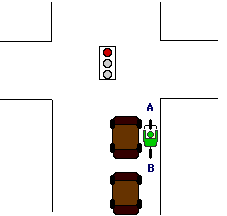
How to avoid this collision:
Don't stop in the blind spot. Simply stop behind a car, instead of to the right of it, as per the diagram below. This makes you very visible to traffic on all sides. It's impossible for the car behind you to avoid seeing you when you're right in front of it.
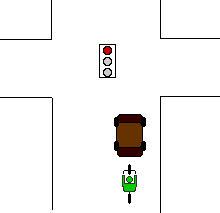
If you chose spot A, then ride quickly to cross the street as soon as the light turns green. Don't look at the motorist to see if they want to go ahead and turn. If you're in spot A and they want to turn, then you're in their way.
Why did you take spot A if you weren't eager to cross the street when you could? When the light turns green, just go, and go quickly. (But make sure cars aren't running the red light on the cross street, of course.)
If you chose spot B, then when the light turns green, DON'T pass the car in front of you -- stay behind it, because it might turn right at any second. If it doesn't make a right turn right away, it may turn right into a driveway or parking lot unexpectedly at any point. Don't count on drivers to signal! They don't.
Assume that a car can turn right at any time. (NEVER pass a car on the right!) But try to stay ahead of the car behind you until you're through the intersection, because otherwise they might try to cut you off as they turn right.
While we're not advocating running red lights, notice it is in fact safer to run the red light if there's no cross traffic, than it is to wait legally at the red light directly to the right of a car, only to have it make a right turn right into you when the light turns green.
The moral here is not that you should break the law, but that you can easily get hurt even if you follow the law.
By the way, be very careful when passing stopped cars on the right as you approach a red light. You run the risk of getting doored by a passenger exiting the car on the right side, or hit by a car that unexpectedly decides to pull into a parking space on the right side of the street
Collision Type #6: The Right Hook

How to avoid this collision:
1. Don't ride on the sidewalk. When you come off the sidewalk to cross the street you're invisible to motorists. You're just begging to be hit if you do this. Keith Vick was killed this way in Austin, TX in Dec. 2002.
2. Ride to the left. Taking up the whole lane makes it harder for drivers to pass you to cut you off or turn into you. Don't feel bad about taking the lane: if motorists didn't threaten your life by turning in front of or into you or passing you too closely, then you wouldn't have to. If the lane you're in isn't wide enough for cars to pass you safely, then you should be taking the whole lane anyway. Lane position is discussed in more detail below.
3. Glance in your mirror before approaching an intersection. (If you don't have a handlebar or helmet mirror, get one now.) Be sure to look in your mirror well before you get to the intersection. When you're actually going through an intersection, you'll need to be paying very close attention to what's in front of you.
Collision Type #7: The Right Hook, pt. 2
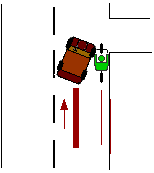
How to avoid this collision:
1. Don't pass on the right. This collision is very easy to avoid. Just don't pass any vehicle on the right. If a car ahead of you is going only 10 mph, then you slow down, too, behind it. It will eventually start moving faster. If it doesn't, pass on the left when it's safe to do so.
When passing cyclists on the left, announce "on your left" before you start passing, so they don't suddenly move left into you. (Of course, they're much less likely to suddenly move left without looking, where they could be hit by traffic, then to suddenly move right, into a destination.) If they're riding too far to the left for you to pass safely on the left, then announce "on your right" before passing on the right.
If several cars are stopped at a light, then you can try passing on the right cautiously. Remember that someone can fling open the passenger door unexpectedly as they exit the car. Also remember that if you pass on the right and traffic starts moving again unexpectedly, you may suffer #3, the Red Light of Death.
Note that when you're tailing a slow-moving vehicle, ride behind it, not in its blind spot immediately to the right of it. Even if you're not passing a car on the right, you could still run into it if it turns right while you're right next to it. Give yourself enough room to brake if it turns.
2. Look behind you before turning right. Here's your opportunity to avoid hitting cyclists who violate tip #1 above and try to pass you on the right. Look behind you before making a right-hand turn to make sure a bike isn't trying to pass you. (Also remember that they could be coming up from behind you on the sidewalk while you're on the street.)
Even if it's the other cyclist's fault for trying to pass you on the right when you make a right turn and have them slam into you, it won't hurt any less when they hit you.
Collision Type #8: The Left Cross
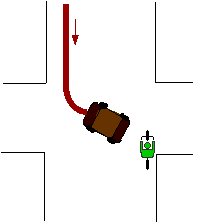
How to avoid this collision:
1. Don't ride on the sidewalk. When you come off the sidewalk to cross the street, you're invisible to turning motorists.
2. Get a headlight. If you're riding at night, you should absolutely use a front headlight. It's required by law in most countries, anyway.
3. Wear something bright, even during the day. It may seem silly, but bikes are small and easy to see through even during the day. Yellow or orange reflective vests really make a big difference. Reflective leg bands are also easy and inexpensive.
4. Don't pass on the right. Don't overtake slow-moving vehicles on the right. Doing so makes you invisible to left-turning motorists at intersections. Passing on the right means that the vehicle you're passing could also make a right turn right into you, too.
5. Slow down. If you can't make eye contact with the driver (especially at night), slow down so much that you're able to completely stop if you have to. Sure, it's inconvenient, but it beats getting hit.
Collision Type #9: The Rear End
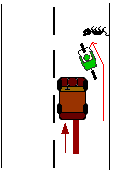
How to avoid this collision:
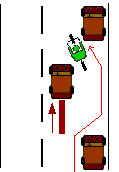
2. Don't swerve in and out of the parking lane if it contains any parked cars. You might be tempted to ride in the parking lane where there are no parked cars, dipping back into the traffic lane when you encounter a parked car. This puts you at risk for getting nailed from behind. Instead, ride a steady, straight line in the traffic lane.
3. Use a mirror. If you don't have one, get one from a bike shop or an online shop right now. There are models that fit on your handlebars, helmet, or glasses, as you prefer. You should always physically look back over your shoulder before moving left, but having a mirror still helps you monitor traffic without constantly having to look behind you.
4. Signal. Never move left without signaling. Just put your left arm straight out. Be sure to check your mirror or loo behind you before signaling (since a car passing too closely can take your arm out).
Collision Type #10: The Rear End, pt. 2
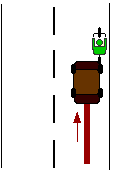
How to avoid this collision:
1. Get a rear light. If you're riding at night, you absolutely should use a flashing red rear light. Bruce Mackey (formerly of Florida, now head of bike safety in Nevada) says that 60% of bike collisions in Florida are caused by cyclists riding at night without lights. In 1999, 39% of deaths on bicycles nationwide occurred between 6 p.m. and midnight. [USA Today, 10-22-01, attributed to the Insurance Institute for highway safety]
Bike shops have red rear blinkies for $15 or less. These kind of lights typically take two AA batteries, which last for months (something like 200 hours). I can't stress this item enough: If you ride at night, get a rear light!
2. Wear a reflective vest or a safety triangle. High quality reflective gear makes you a lot more visible even in the day time, not just at night. I had a friend ride away from me while wearing one during the day, and when she was about a quarter mile away, I couldn't see her or her bike at all, but the vest was clearly visible. At night the difference is even greater. Bike shops have vests and triangles for $10 to $15. Also, when you hear a motorist approaching, straightening up into a vertical position will make your reflective gear more noticeable.
3. Choose wide streets. Ride on streets whose outside lane is so wide that it can easily fit a car and a bike side by side. That way a car may zoom by you and avoid hitting you, even if they didn't see you!
4. Choose slow streets. The slower a car is going, the more time the driver has to see you. I navigate the city by going through neighborhoods. Learn how to do this.
5. Use back streets on weekends. The risk of riding on Friday or Saturday night is much greater than riding on other nights because all the drunks are out driving around. If you do ride on a weekend night, make sure to take neighborhood streets rather than arterials.
6. Get a mirror. Get a mirror and use it. If it looks like a car doesn't see you, hop off your bike and onto the sidewalk. Mirrors cost $5-15. Trust me, once you've ridden a mirror for a while, you'll wonder how you got along without it.
My paranoia went down 80% after I got a mirror. If you're not convinced, after you've used your mirror for a month, take it off your bike and ride around and notice how you keep glancing down to where your mirror was, and notice how unsafe you feel without it.
7. Don't hug the curb. This is counter-intuitive, but give yourself a little space between yourself and the curb. That gives you some room to move into in case you see a large vehicle in your mirror approaching without moving over far enough to avoid you. Also, when you hug the curb tightly you're more likely to suffer a right cross from motorists who can't see you.
Adapted with permission from www.bicyclesafety.com.
